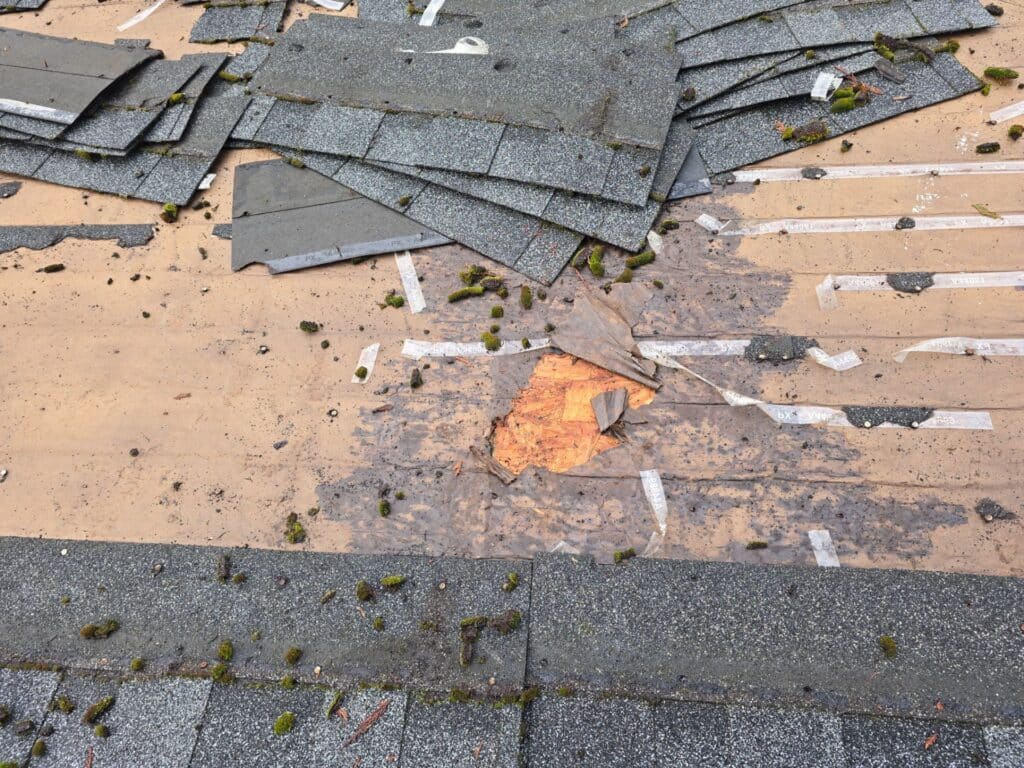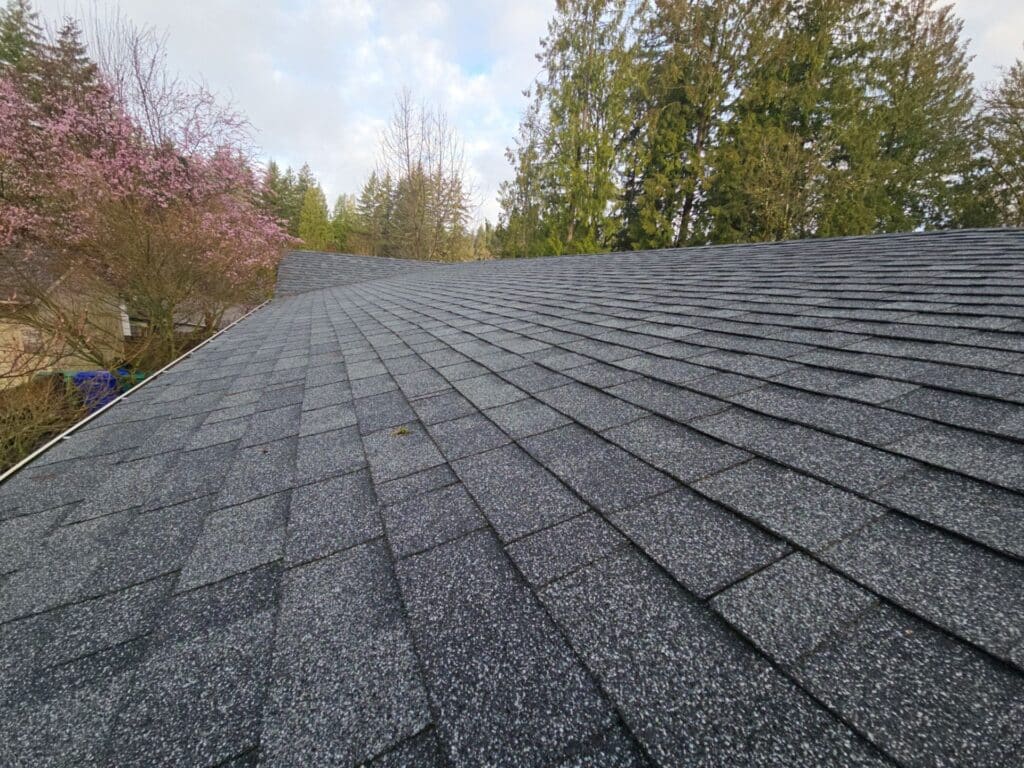Did a Storm Just Hit? Here’s What You Need to Know About Your Roof
You’re standing in your yard, looking up at your roof, and something doesn’t seem right. A few shingles are missing, a branch is hanging off the edge, and you’re wondering how bad is the damage?
Storms can be unpredictable, and even if your roof looks okay from the ground, there could be hidden issues waiting to cause bigger problems. Whether it was strong winds, heavy rain, or hail, knowing what to do next can make all the difference in protecting your home and your wallet.
This post will walk you through how to assess roof storm damage, what steps to take right away, and when to call in a professional for storm damage roof repair. Let’s start with what you should do first.

The storm has passed, but now you’re left wondering is my roof okay? Maybe you heard the wind howling, hail pounding, or branches crashing, and now you’re concerned about damage to your roof. Before you do anything, take a breath and remember: safety first.
Look outside for any obvious hazards. If you see downed power lines, large debris, or flooding around your home, stay put and call for help. If it seems safe, step outside and check your roof from the ground. Do you notice missing shingles, dented gutters, or tree branches on the roof? If so, there’s a good chance your roof took some damage.
You don’t need to climb up on the roof to spot problems that can be risky, especially right after a storm. Instead, do a quick visual check from the ground. Look for things like missing or curled shingles, cracked flashing, or pieces of roofing material on the ground. If you have an attic, take a flashlight and check for any signs of water damage, leaks, or damp insulation.
Not all damage is obvious, though. Sometimes, the real issues are hidden beneath the surface, which is why a professional roof inspection is a smart move. A reputable roofer can spot things you might miss and let you know if you need a simple roof repair or something more extensive.
If you notice your roof has storm damage, don’t panic. Small steps can prevent bigger problems while you wait for repairs. If there’s a leak, place a bucket under the drip and move valuables away from the area. If there are exposed sections on the roof and rain is in the forecast, you can place a tarp over the damaged area to keep water out.
However, these are just temporary solutions. It’s best to call a roofing company as soon as possible to inspect the damage and recommend the best course of action.
Not all storms leave behind the same kind of damage. Wind, hail, and heavy rain can each take a toll on your roof and home in different ways.
Sometimes, roof damage is obvious like when you find shingles in your yard. Other times, it’s more subtle. If you notice any of the following, it’s time to get your roof inspected:
A professional roof inspection can confirm whether you need a roof repair or if it’s time to replace your roof.

This is one of the biggest questions homeowners ask after a storm: Do I need a full roof replacement, or will a repair be enough? The answer depends on how extensive the damage is.
The cost depends on factors like the type of roof, extent of damage, and your homeowners insurance policy. Some homeowners insurance policies will help cover the costs if the damage to your roof was caused by a covered event like hail or wind.
If you decide to file a claim, your insurance company will send an adjuster to inspect the damage. If your claim is approved, they may pay for part (or all) of the repair or roof replacement, depending on your insurance policies.
If the cost of repairs is high, it’s worth seeing if your homeowners insurance will cover it. However, if the damage is minor and close to your deductible, it might not be worth filing a roof damage claim. A reputable roofing contractor can help you decide whether it makes sense to involve your insurance company or just handle the repair out of pocket.
After a storm, one of the first things homeowners ask is: "Will my insurance cover this?" The answer depends on your insurance policy and how your roof is valued.
Insurance companies generally use two types of policies when covering roof storm damage:
Not sure which one you have? Contacting your insurance company or speaking with your insurance agent can help clarify.
Most homeowners insurance policies cover wind or hail damage as long as it wasn’t due to wear and tear or a pre-existing issue. If your roof has storm damage from high winds or hail marks from a recent storm, you’ll likely have a viable claim. However, policies can vary some won’t cover water damage unless it’s directly caused by the storm (like a hole in the roof allowing rain in).
Your roof damage claim could be denied if:
If your claim is approved, it’s important to make sure the scope of work matches what’s actually needed to protect your home. A storm damage roof inspection by a reputable roofing company can help ensure your claim is properly valued.
Insurance companies want proof. The more evidence you provide, the smoother your insurance claim process will be.
After the storm, take clear photos of the damage to your roof. Capture missing shingles, hail damage to your roof, and any water damage inside your home. If possible, get a professional roof inspection some roofing companies even assist with marking roof damage using chalk so adjusters can see the extent of the issue.
Once you file a claim, your insurance company will send an adjuster to inspect the damage. While they are trained to assess storm damage, they don’t always catch everything. That’s why many homeowners choose to have a roofing contractor present during the inspection. A reputable roofing company can point out hail marks, wind damage, and other hidden issues to make sure your claim is valued correctly.
If your roof damage claim is denied, don’t assume it’s final. You can:
Sometimes, insurance companies underestimate the cost of repairs or argue that the damage occurs over time rather than from a single storm. If this happens, a storm damage roof inspection from a trusted roofing contractor can help build a stronger case.
After a storm, many homeowners rush to get a roofing contractor, but choosing the right one is critical. The best contractors should be:
A professional roofer should also provide a clear breakdown of the repair or replacement process, including the roof material, type of roof, replacement cost, and how they’ll handle the scope of work.
After a big storm, you may see door-to-door roofing companies offering quick fixes. Be cautious. Many of these are storm chasers contractors who show up, take deposits, and either cause more damage or disappear without completing the work.
Signs of a scam roofing company:
Always check reviews, ask for credentials, and confirm they are a reputable roofing company.
Before you choose a contractor to get your roof replaced or repaired, ask:
Choosing the right roofing contractor makes all the difference in how smoothly your roof claims process goes and whether you get a quality new roof that lasts.

If you've ever had to deal with storm damage to your roof, you know how frustrating it can be. Even if you got everything repaired, the thought of another storm rolling in can be stressful. The good news? There are ways to protect your home and minimize future damage so you’re not caught off guard next time.
Think of your roof like your car it needs regular check-ups to stay in good shape. A professional roof inspection at least once a year can catch small problems before they turn into big ones. Loose shingles, worn-out flashing, or clogged gutters might not seem like a big deal now, but during a storm, they can make your home more vulnerable.
A simple example? A homeowner we worked with thought their roof was fine after a recent storm. When we checked, we found a few cracked shingles and some minor roofing wind damage. They decided to fix it, and sure enough, a few months later, another storm hit. Their neighbors had storm damage roof replacement bills to deal with, but their home was safe because they took action early.
If your roof damage was severe enough to require a replacement, it’s worth considering storm-resistant materials. Modern roofing technology has come a long way impact-resistant shingles, metal roofing, and reinforced underlayment can all help your roof stand up to high winds and hail.
We’ve seen homeowners replace older asphalt shingles with Class 4 impact-resistant shingles, and it made a huge difference. Not only did it help protect their home, but in many cases, their storm damage roof insurance claim resulted in lower premiums because of the upgrade.
Beyond materials, there are a few extra steps you can take to reinforce your roof against future storms. Simple things like securing loose flashing, reinforcing roof decking, and ensuring proper attic ventilation can make a big difference when the next storm hits.
One homeowner in a wind-prone area had multiple shingles blow off with every storm. They upgraded to a roofing system with high-wind-rated shingles and additional fasteners, and for the first time in years, their roof held up without a single missing shingle. These types of preventative measures can save you from repeated repairs and insurance claims.
Dealing with storm damage to your roof can be stressful, but taking the right steps immediately after a storm can make the process much easier. First, make sure your home is safe. Then, check for visible damage from the ground and call a professional for a storm damage roof replacement or repair evaluation.
If your roof needs major repairs, don’t wait too long to file a storm damage roof insurance claim. Many insurance policies have time limits, and the longer you wait, the harder it can be to prove the damage was caused by the storm.
Most importantly, consider long-term solutions to avoid dealing with the same problem in the future. Investing in storm-resistant materials and regular inspections can help protect your home and reduce future insurance claims.
When in doubt, reach out to a trusted roofing professional like IBEX Roof. A knowledgeable roofer can help you understand whether you need a repair or full replacement, guide you through the insurance claim process, and make sure your home is protected for years to come.
After a storm, look for missing or cracked shingles, dented gutters, water stains on ceilings, or granules in your gutters. If you're unsure, a professional roof inspection can confirm if there's hidden damage.
It depends on your policy. Most storm damage roof insurance claims cover damage caused by wind or hail, but some policies may only cover the actual cash value of your roof rather than the full replacement cost. It’s always best to check with your insurance provider.
Most insurance policies require you to file a claim within six months to a year after the storm, but it varies by provider. The sooner you act, the better your chances of getting your claim approved.
You might be able to replace a few missing shingles, but be cautious small issues can sometimes hide bigger problems. A professional roofer can assess the damage properly and make sure your roof is fully repaired.
If you live in a storm-prone area, consider impact-resistant shingles, metal roofing, or reinforced asphalt shingles. These materials are designed to withstand strong winds and hail better than standard shingles.